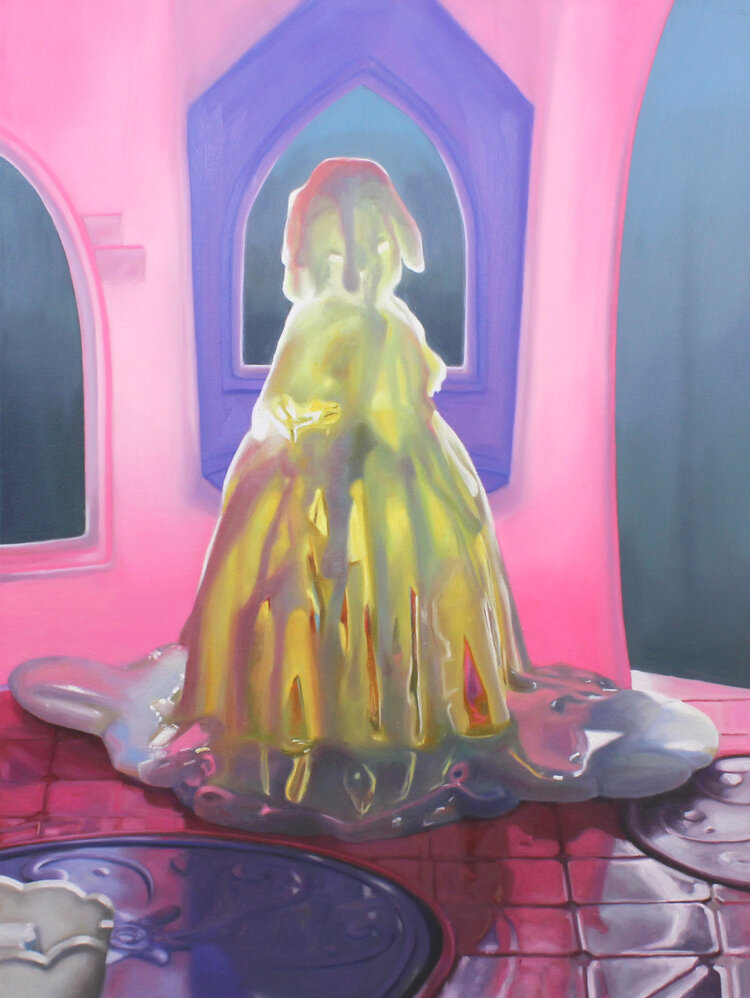
Emily Blair Quinn, Melting–Point, 2020, oil on canvas, 40” x 30”

Emily Blair Quinn, Melting–Point, 2020, oil on canvas, 40” x 30”
A virtual view of the group show "Strangers in Stranger Lands," up now at Marquee Projects in Bellport, New York, stimulates my virus- and Donald Trump-saturated imagination. As a symptom of my anxiety, the show’s childlike images of innocence, exploration, and generosity spawn conflicting judgments, seeming by turns–vulnerable or creepy. Heavy on painting and steeped in charged fantasy, the exhibit disarms realistic, adult control.
Addressing estrangement or foreignness in one’s homeland or another country, gallerist Mark Van Wagner titled the show after sci-fi writer Robert A. Heinlein’s Stranger in a Strange Land. The exhibit can’t help but to summon America’s current polarizing leadership, collective insecurity, and injustices concerning race, class, status, citizenship, and sexual orientation.
Van Wagner quotes Heinlein at the start of the press release: “There comes a time in the life of every human when he or she must decide to risk ‘his life, his fortune and his sacred honor’ on an outcome dubious. Those who fail the challenge are merely overgrown children, can never be anything else.” Thus, for Heinlein, avoiding risk would be supremely irresponsible. Presenting possible threats on par with safety, "Strangers in Stranger Lands" solicits unchaperoned participation and unscripted reactions.
Janet Maya’s partially erased faces depict Quaker-like humility congruent with a loss of identity. My gaze lingers over the balance and reversals of Girls 2, returning for refreshment to four submerged feet. Carol Saft’s diminutive bronze sculptures Kneeling Man/Sprawling Man and Fireman’s Carry exemplify mutual human aid and the timeless value of the social contract: Shushing Man, having listened and heard, soothes and comforts with his entire body. A glazed stoneware piece, Angelica Bound by Peter Schlesinger, portrays the fleshy beauty before she is rescued by Knight Roger, turning toward the rock that she’s tied to, less in pain than in wonder.
Like kids who can fix their parents’ computers, Felipe Ariza Castro, Philip Gerald, Brandon Lipchik and Emily Blair Quinn mix analog skills with digital computer processes and imagery. Castro paints his images on computer, prints them on aluminum sheets, then layers on more paint. Ultra Violet Light and Portrait of a Young Woman thrum in hypersensitive frontal engagement; the figure in Art turns away, being less interested in the viewer than what a digital watch does to landscape. Gerald’s happy-faced Bootleg Caravaggio has fun with art history (OMG, Baroque Art is so like, funny and old), punctuating an airbrushed, dot-and-dash spectacle with a carefree outdoor pee. Also cavorting naked in Eden, Lipchik’s Garden Tools, a “woody” favorite, unabashedly shows some pimpled “cheek” among commercial-looking flowers, hammers, hands, a Greek vase, tennis balls, and a drawing that looks like a spine. Quinn’s Melting Point mimics the digital computer, lit-from-within glow of a Disney-esque, candlewax girl of an indeterminate mood: whoever she is, she makes a convenient vehicle for projected feeling.
Four painters cement the insecure and weird core of "Strangers in Stranger Lands." Saturn Rising, After the Gold Rush and Visiting Wraith by Mary DeVincentis dramatize wacky events with spaceships and monsters via richly textured and deeply felt nature: her sensual figures in Leaving the Moment, Blue, and Handless Maiden have lost a head or hands but they commune prophetically with trees and sky. A special treat: Genieve Figgis’ painting Las Meninas After Velázquez dissolves the familiar 17th century masterpiece to bare bones composition, luscious surface, hollow-eyed princess and her melting court; fetching the subject back from a Master’s control with galloping feminine power. Likewise, the gorgeous, fluid Pink Sky, rescues a boating couple from being too cute with a sunset that looks suspiciously like female genitals. Carly Haffner’s Dave Taking Photos, Red Sky Bridgehampton, Cherry Tree, and especially Snow Cat are so unguarded in execution, that they reject suburban order using its own resources: pleasing design, solid color and vast empty space seem to unwittingly betray suppression. On the opposite side of the cynic’s spectrum, Peggy Robinson’s paintings, Dunkin Donuts, Girl in a Blue Dress, Boat for Sale, Incinerator, Whirlpool and 3 boys convey worldliness through tone, setting, and scale as in Film Noir. The figures in her paintings seem to anticipate a brawl, a murder, an accident, a sexual encounter gone wrong or another inexorable fate.
Personal unease and entrenched stress freely inhabit the characters and landscapes of "Strangers in Stranger Lands": “Anything Goes” and “Anything Can Happen” is resolved as both boon and threat, a key step in acclimating to the new normal.
[Strangers in Stranger Lands runs at Marquee Projects in Bellport, NY through July 26, 2020.]
[About the author: Elizabeth Johnson is an artist and writer.]